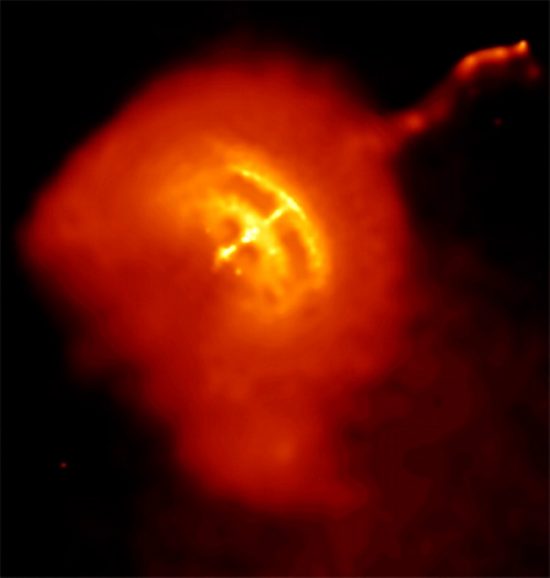
November 25, 2020
Jet-like structures from PSRJ1135–6055.
The standard model of stellar evolution proposes that pulsars are neutron stars rotating at incredible speed. For example, PSRJ1135–6055, is reported to be spinning at almost 43,000 revolutions per minute (RPM). To put that rotational rate in perspective, the blades of a typical kitchen blender do not exceed 30,000 RPM.
Recently, astronomers announced that the pulsar is emitting jets of material:
“The origin of these extended jet-like structures is unknown, but their length, almost-rectilinear geometry, and misaligned orientation with respect to the pulsar proper motion are difficult to accommodate in the framework of canonical pulsar jet formation theories.”
Astronomers believe that a neutron star occurs when a star with sufficient mass collapses at the end of its life cycle. Gravity is so great that the star cannot resist the forces that compress its electrons into the atomic nuclei that make up its structure. This means that it can become as small as a city block, but its substance can weigh 10^12 kilograms per milliliter. As the theory states, when the star contracts, angular momentum increases, resulting in rapid rotation.
A putative neutron star’s magnetic field can becomes focused at each pole, according to conventional theories, creating a narrow beam of radio waves like the twin beams of a lighthouse. Astronomers assume a large population of neutron stars in the Milky Way, so a population of pulsars must also exist.
Rather than relying on kinetic energy, Electric Universe advocates assume that the oscillations and jets in pulsars are due to synchronous resonance in electric circuits. Electricity stored in double layers is responsible for their energetic outbursts.
A double layer is defined as “…an electric charge separation region that forms in a plasma. It consists of two oppositely charged parallel layers, resulting in a voltage drop and electric field across the layer, which accelerates the plasma’s electrons and positive ions in opposite directions, producing an electric current. Large potential drops and layer separation may accelerate electrons to relativistic velocities (i.e. close to the speed of light), and produce synchrotron radiation. Double layers may be found anywhere that plasmas are found, from discharge tubes to space plasmas to the Birkeland currents supplying the Earth’s aurora.” [Ian Tresman: The Plasma Dictionary]
Pulsars do not shine with visible light alone; sometimes X-rays and gamma rays are seen. The outbursts begin with a sudden peak of energy, and then gradually decline, like a stroke of lightning.
According to the press release, PSRJ1135–6055 is creating what astronomers call a “pulsar wind nebula”.
Whenever electricity flows through clouds of dusty plasma, it concentrates forces because of the Biot-Savart effect, drawing itself into helical zones called “z-pinches” or “Bennett pinches.” Depending on how much electricity is flowing through the circuit, any one star’s magnetic field will be greater where there is more current.
Pulsars are most likely immense concentrations of electricity being focused by some kind of “dense plasma focus” effect, as mentioned in a recent Picture of the Day. It provides a precise mechanism by which cosmic electric currents can influence the evolution and morphology of space structures [See Peratt, A. L. and Dessler, A. J. “Filamentation of Volcanic Plumes on the Jovian Satellite Io.” Astrophysics and Space Science volume 144, numbers 1-2, May 1988, pages 451-461].
Electric Universe author and speaker Wal Thornhill addressed the neutron star/pulsar issue this way:
“It is assumed that a supernova can ‘squeeze’ stellar protons and electrons together to form neutrons.
“A first-order wild conjecture. The model incorporates many unproven assumptions about the unseen internal structure of stars. If the implosion is not spherically symmetrical there may be insufficient ‘squeeze’ to force protons and electrons to merge, even if that were possible. No account is taken of electrical effects. Our own Sun with a mean density only slightly above that of pure hydrogen, shows that electrostatic forces are at work within stars to offset compression forces. When not associated with protons in a nucleus, neutrons decay into protons and electrons in a few minutes. Atomic nuclei with too many neutrons are unstable. If it were possible to form a neutron star, why should it be stable?”
The electric model of stellar evolution and behavior provides superior explanations when it comes to astronomical observations.
Stephen Smith












